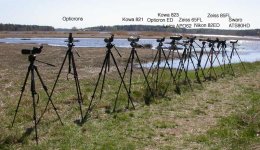Hello to all,
I was wondering if anyone had done any comparisons between the latest 62/65mm offerings from Leica and Zeiss. I have been a big fan of Leica for years and am considering a 62 APO, but I have also heard some good things about the Diascope as well.
I really appreicate bright, crisp optics, but I am not into digiscoping. I also like the compact size of the ~60s ( I currently own a Fieldscope III ED AN).
Does anyone have experience with both the small Leica and Zeiss models?
Thanks to all for the help.
Rgds,
Steffan
I was wondering if anyone had done any comparisons between the latest 62/65mm offerings from Leica and Zeiss. I have been a big fan of Leica for years and am considering a 62 APO, but I have also heard some good things about the Diascope as well.
I really appreicate bright, crisp optics, but I am not into digiscoping. I also like the compact size of the ~60s ( I currently own a Fieldscope III ED AN).
Does anyone have experience with both the small Leica and Zeiss models?
Thanks to all for the help.
Rgds,
Steffan




